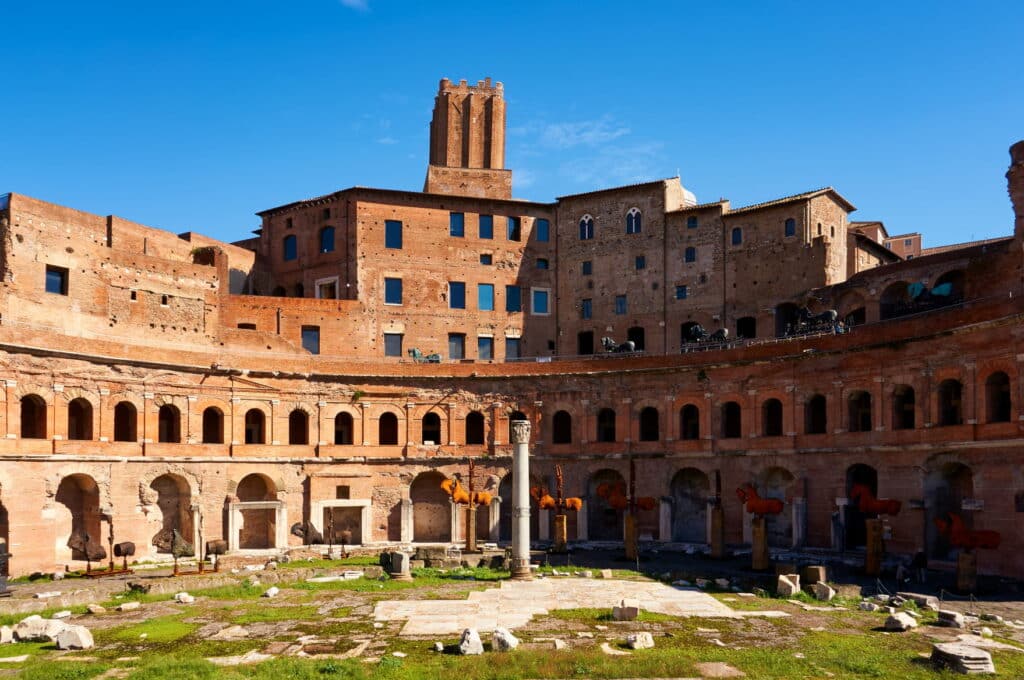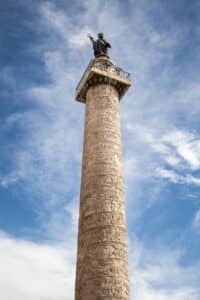
The entrance fee for Trajan’s Markets and Imperial Forum Museum is 15€ as of 2025. If you want to buy a ticket with multimedia option, the price of this option is 28€. You can also book a guided tour of Trajan’s Markets and the Imperial Forums.
The Forum of the Emperor Trajan (AD. 98-117), the last, largest and best preserved on the Imperial fora, comprised a considerable complex of buildings, including a temple and basilica as well as three monuments erected in honour of the Emperor himself – a triumphal arch, an equestrian statue and a victory column. The markets extended northeast up the Quirinal hill.

View of Trajan’s Markets and Trajan’s Forum in Rome, Italy
The forum, designed by Apollodorus of Damascus, was begun in AD. 1 07 and completed in 143. During the Middle Ages new buildings were erected in the area of the forum by the Colonna and Caetani families, among them the Torre delle Milizie still to be seen in Via Quattro Novembre, and later the twin churches of Santa Maria di Loreto and the Santissimo Nome di Maria were also built here. In the first half of the present century a wide motor road and a number of smaller streets were laid out in the area.

The Trajan’s Forum
Excavations carried out since 1928 have revealed the layout of the forum. A triumphal arch erected in AD. 116 gave access to an open rectangular area, in the centre of which stood an equestrian statue of the Emperor. At the far end was the Basilica Ulpia, a hall measuring 130 by 125 m. In the present state of the site it is difficult to imagine a building of these dimensions; and indeed it was no easy matter at the time it was built to find space for it in this crowded part of central Rome. Built on to the rear of the basilica were two libraries, one for Latin and the other for Greek literature, and between the two reared up Trajan’s victory column. Beyond this, at the end of the forum (between the two churches dedicated to the Virgin), was a temple of the deified Trajan. Only Trajan’s Column is left to represent this whole complex, much admired in ancient times, dedicated to honouring the Emperor under whom the Roman Empire reached its greatest extent.
Trajan’s Column
This victory column, nowsuffering increasing damage from the elements and the polluted air of Rome, is a magnificent monument to Roman Imperial power and the skill of Roman sculptors. The column, 38 m. high and constructed of marble from the Greek island of Paros, is covered with a spiral frieze 200 m long, with over 2500 figures, depicting Trajan’s wars with the Dacians in 101 -102 and 105-106.

Trajan’s Column
This whole frieze, with its fighting soldiers, prancing horses and the whole panoply of Roman military equipment, is worth studying in detail – though this is more difficult for the modern visitor than for the ancients, who could examine the reliefs from the windows of the two libraries. A spiral staircase of 185 steps runs up inside the column, lit by 43 narrow slits in the wall of the column. In the base of the column was a golden urn containing the Emperor’s ashes, and on its summit was a golden statue of Trajan. The statue was lost during the Middle Ages, and in 1 588 Pope Sixtus V replaced it with a figure of the Apostle Peter with his key.
Trajan’s Markets
To the north of Trajan’s Forum was a semicircular range of market halls in three tiers, the ruins of which, with their red-brick walls and high vaulted roofs, form an impressive termination to the group of Imperial fora, rising up the slopes of the Quirinal hill to Via Quattro Novembre. The difference in level was skilfully exploited by the architect, Apollodorus of Damascus (early 2nd c). In establishing his markets Trajan was concerned to ease thefinancial burdens of the population by maintaining prices at a reasonable level and to reduce social tensions by the distribution of Imperial subsidies.

Trajan’s Markets

